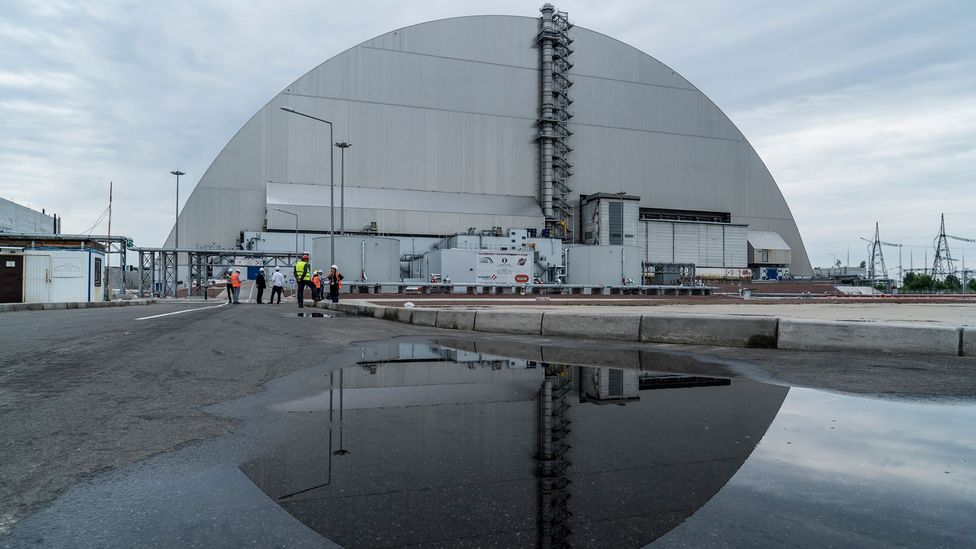Springtime was always the busiest time of year for the women working at the wool processing plant in Chernihiv, northern Ukraine. More than 21,000 tons of wool passed through the factory from farms all across the country during the annual sheep shearing period. The April and May of 1986 were no exception.
The workers pulled 12-hour shifts as they sorted the piles of raw fleece by hand before they were washed and baled. But then the women started getting sick.
Some suffered nosebleeds, others complained of dizziness and nausea. When the authorities were called to investigate, they found radiation levels in the factory of up to 180mSv/hr. Anyone exposed at these levels would exceed the total annual dose considered to be safe in many parts of the world today in less than a minute.
You might also like:
• The bold plan to give Chernobyl a new life
• The bunkers built to survive an apocalypse
• How plants have reclaimed Chernobyl’s poisoned land
Fifty miles away was the Chernobyl nuclear power plant. On 26 April 1986 reactor number four at the power plant suffered a catastrophic explosion that exposed the core and threw clouds of radioactive material over the surrounding area as a fire burned uncontrollably.
But Chernihiv was regarded to be well outside the exclusion zone that was hastily thrown up around the stricken plant and readings elsewhere in the town had shown it to have comparatively low levels of radiation.
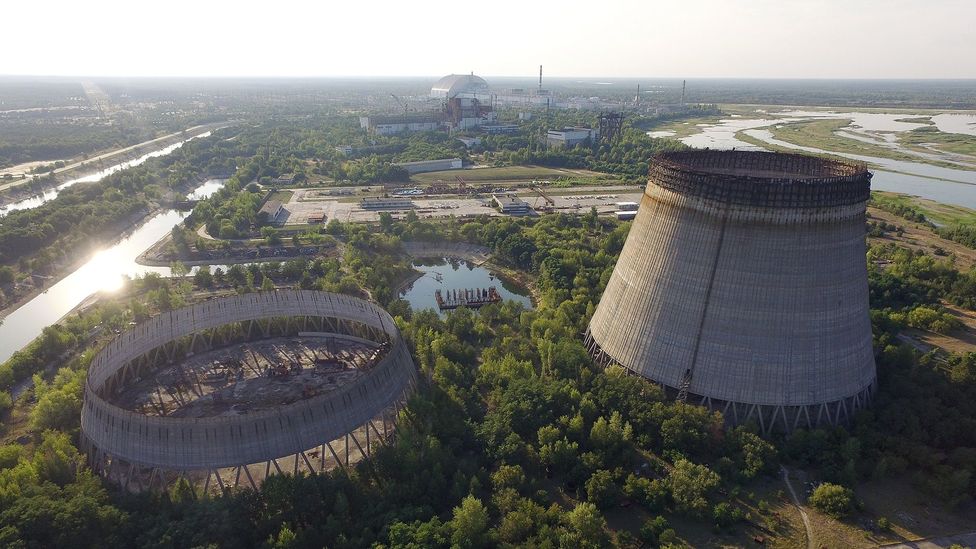
The number of deaths and illnesses caused by the radiation emitted from Chernobyl after the accident remains a contentious subject (Credit: Getty Images)
“The area was yellow on the radiation maps which means the town didn’t get hit very hard,” says Kate Brown, a science historian at the Massachusetts Institute of Technology (MIT). “Yet there were 298 women in this factory who were given liquidator status, which was normally reserved for those who had documented exposures during the early days of the clean-up after the accident.”
Brown uncovered the story of the Chernihiv wool workers as part of her research into the impact of the Chernobyl disaster. Her determination to unravel the true cost of the disaster has seen her travel to many parts of Ukraine, Belarus and Russia, to interview survivors, trawl through official archives and search old hospital reports.
In 2005 the UN predicted a further 4,000 people might eventually die as a result of radiation exposure from Chernobyl
According to the official, internationally recognised death toll, just 31 people died as an immediate result of Chernobyl while the UN estimates that only 50 deaths can be directly attributed to the disaster. In 2005, it predicted a further 4,000 might eventually die as a result of the radiation exposure.
Brown's research, however, suggests Chernobyl has cast a far longer shadow.
“When I visited the wool factory in Chernihiv, I met some of the women who were working at the time,” she says. “There were just 10 of these women still there. They told me that they were picking up bales of wool and sorting them on tables. In May 1986, the factory was getting wool that had radiation readings of up to 30Sv/hr. The bales of wool the women were carrying were like hugging an X-ray machine while it was turned on over and over again.”
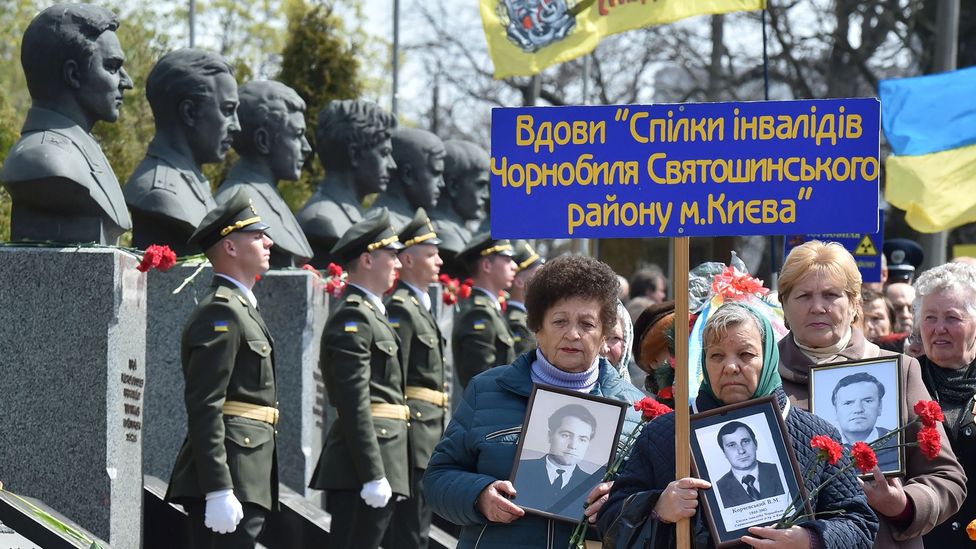
The Ukrainian government pays benefits to more than 36,000 widows of men who have died as a result of the Chernobyl disaster (Credit: Getty Images)
Thousands of animals were slaughtered in the area around Chernobyl as it was being evacuated. Brown believes fleeces from some of these animals appear to have found their way to the factory in Chernihiv along with other contaminated wool from farms enveloped in the clouds of radioactive material that spread out across northern Ukraine.
When Brown spoke to the 10 “liquidators” at the wool factory, their stories gave a grim picture of what appears to have happened all across the region as ordinary people who had nothing to do with the clean-up of the disaster were exposed to radioactive material.
“They pointed to different parts of their bodies that had aged more than the rest and where they had health problems,” says Brown. “They knew all about which radioactive isotopes had lodged in their organs.” The other 288 women, they told her, had either died or had taken pensions for ill health.
In the weeks and months that followed the Chernobyl disaster, hundreds of thousands of firefighters, engineers, military troops, police, miners, cleaners and medical personnel were sent into the area immediately around the destroyed power plant in an effort to control the fire and core meltdown, and prevent radioactive material from spreading further into the environment.
These people – who became known as “liquidators” due to the official Soviet definition of “participant in liquidation of the Chernobyl nuclear power plant accident consequences” – were given a special status that meant they would receive benefits such as extra healthcare and payments. Official registries indicate that 600,000 people were granted liquidator status.
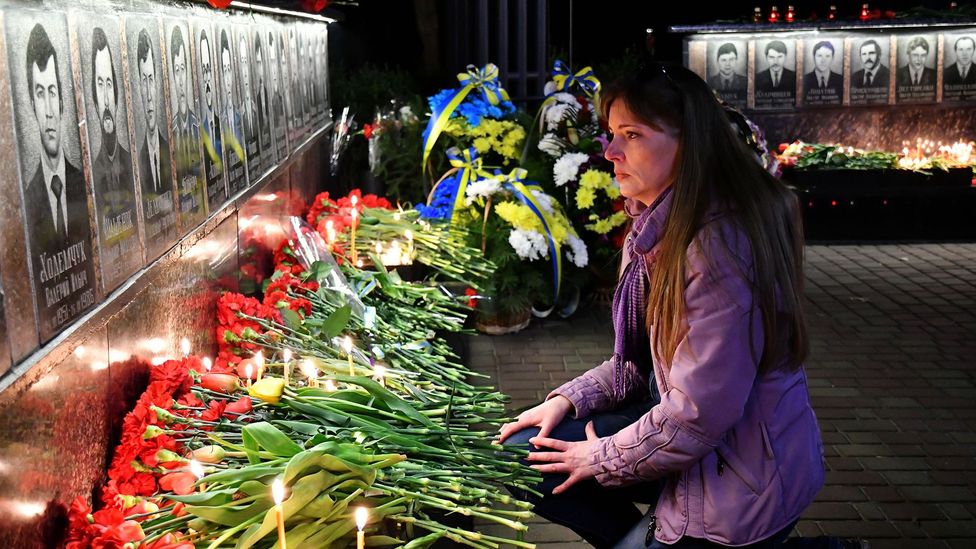
Thirty one engineers, firemen and emergency clean-up workers are officially recognised as dying in the first three months after the explosion (Credit: Getty Images)
But a contentious report published by members of the Russian Academy of Sciences indicates that there could have been as many as 830,000 people in the Chernobyl clean-up teams. They estimated that between 112,000 and 125,000 of these – around 15% – had died by 2005. Many of the figures in the report, however, were disputed by scientists in the West, who questioned their scientific validity.
The Ukrainian authorities, however, kept a registry of their own citizens affected by the Chernobyl accident. In 2015 there were 318,988 Ukrainian clean-up workers on the database, although according to a recent report by the National Research Centre for Radiation Medicine in Ukraine, 651,453 clean-up workers were examined for radiation exposure between 2003 and 2007. A similar register in Belarus recorded 99,693 clean-up workers, while another registry including included 157,086 Russian liquidators.
In Ukraine, death rates among these brave individuals has soared, rising from 3.5 to 17.5 deaths per 1,000 people between 1988 and 2012. Disability among the liquidators has also soared. In 1988 68% of them were regarded healthy, while 26 years later just 5.5% were still healthy. Most – 63% – were reported to be suffering from cardiovascular and circulatory diseases while 13% had problems with their nervous systems. In Belarus, 40,049 liquidators were registered to have cancers by 2008 along with a further 2,833 from Russia.
The International Atomic Energy Agency, however, says that health studies on liquidators have “failed to show any direct correlation between their radiation exposure” and cancer or other disease.
Some of those living closest to the power plant received internal radiation doses in their thyroid glands that were up to 37,000 times the dose of a chest x-ray
Another group who bore the brunt of the radiation exposures in the hours and days after the explosion were those living in the nearby town of Pripyat and the surrounding area. It took a day and a half before the evacuation began and led to 49,614 people being evacuated. Later a further 41,986 people were evacuated from another 80 settlements in a 30km (18.7 mile) zone around the power plant, but ultimately some 200,000 people are thought to have been relocated as a result of the accident.
Some of those living closest to the power plant received internal radiation doses in their thyroid glands of up to 3.9Gy – roughly 37,000 times the dose of a chest x-ray – after breathing radioactive material and eating contaminated food. Doctors who have been studying the evacuees report that mortality among the evacuees has gradually increased, reaching a peak in 2008-2012 with 18 deaths per 1,000 people.
But this still represents a small proportion of the people affected by Chernobyl.
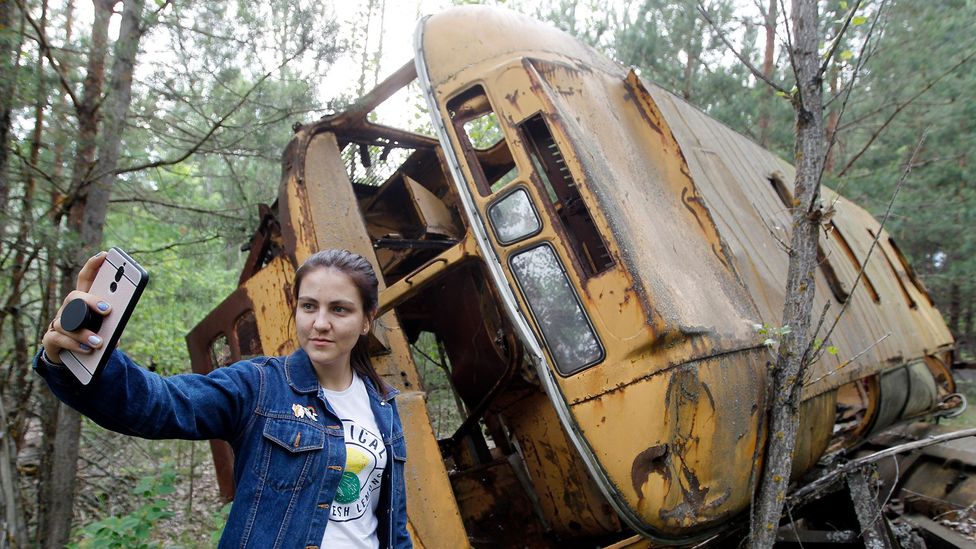
Almost 100,000 people were evacuated from the area around Chernobyl in the months after the disaster but today the abandoned towns attract tourists (Credit: Getty Images)
Brown has found evidence hidden in hospital records from around the time of the accident that show just how widespread problems were.
“In hospitals throughout the region and as far away as Moscow, people were flooding in with acute symptoms,” she says. “The accounts I have indicate at least 40,000 people were hospitalised in the summer after the accident, many of them women and children.”
Political pressure is widely thought to have led to the true picture of the problem to be suppressed by the Soviet authorities, who were keen not to lose face on the international stage. But following the collapse of the USSR and as people living in the areas that were exposed to radiation begin to present with a wide range of health problems, a far clearer picture of the toll taken by the disaster is emerging.
The Chernobyl disaster is the largest anthropogenic disaster in the history of humankind
Viktor Sushko, deputy director general of the National Research Centre for Radiation Medicine (NRCRM) based in Kiev, Ukraine, describes the Chernobyl disaster as the “largest anthropogenic disaster in the history of humankind”. The NRCRM estimate around five million citizens of the former USSR, including three million in Ukraine, have suffered as a result of Chernobyl, while in Belarus around 800,000 people were registered as being affected by radiation following the disaster.
Even now the Ukrainian government is paying benefits to 36,525 women who are considered to be widows of men who suffered as a result of the Chernobyl accident.
As of January 2018, 1.8 million people in Ukraine, including 377,589 children, had the status of victims of the disaster, according to Sushko and his colleagues. There has been a rapid increase in the number of people with disabilities among this population, rising from 40,106 in 1995 to 107,115 in 2018.
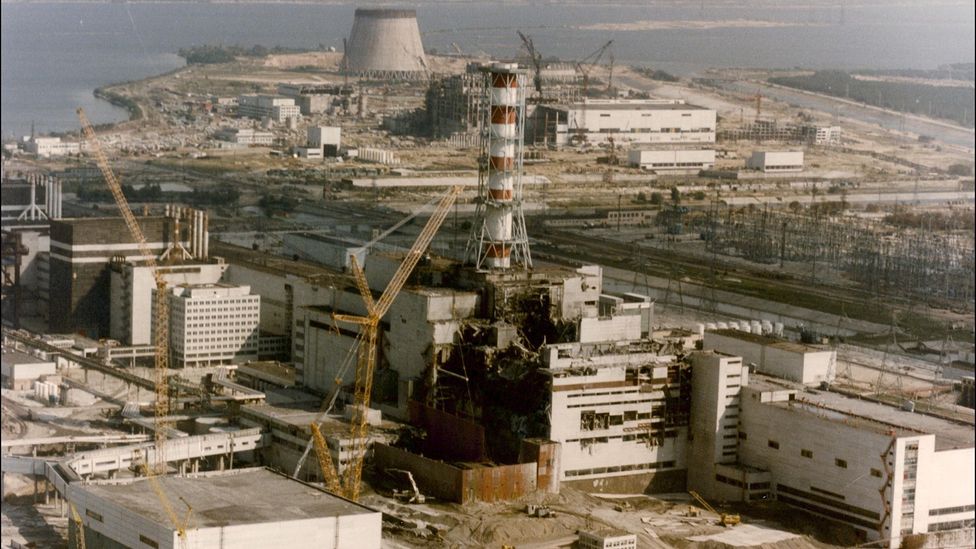
The explosion that exposed the core in reactor number four at Chernobyl happened during a safety test and spread highly reactive material (Credit: Getty Images)
Interestingly, Sushko and his team also report that the number of Chernobyl victims in Ukraine has decreased by 657,988 since 2007 – a fall of 26%. Although they don’t explain why, this is likely to be partly due to migration as victims have left the country, reclassification of victim status and, inevitably, some deaths.
Mortality rates in radiation contaminated areas have been growing progressively higher than the rest of the Ukraine. They peaked in 2007 when more than 26 people out of every 1,000 died compared to the national average of 16 for every 1,000.
In total some 150,000sq km (57,915 sq miles) of Belarus, Russia and Ukraine are considered to be contaminated and the 4,000sq km (1,544 sq miles) exclusion zone – an area more than twice the size of London – remains virtually uninhabited. But radioactive fallout, carried by winds, scattered over much of the Northern Hemisphere. Within two days of the explosion, high levels of radiation were picked up in Sweden while contamination of plants and grasslands in Britain led to strict restrictions on the sale of lamb and other sheep products for years.
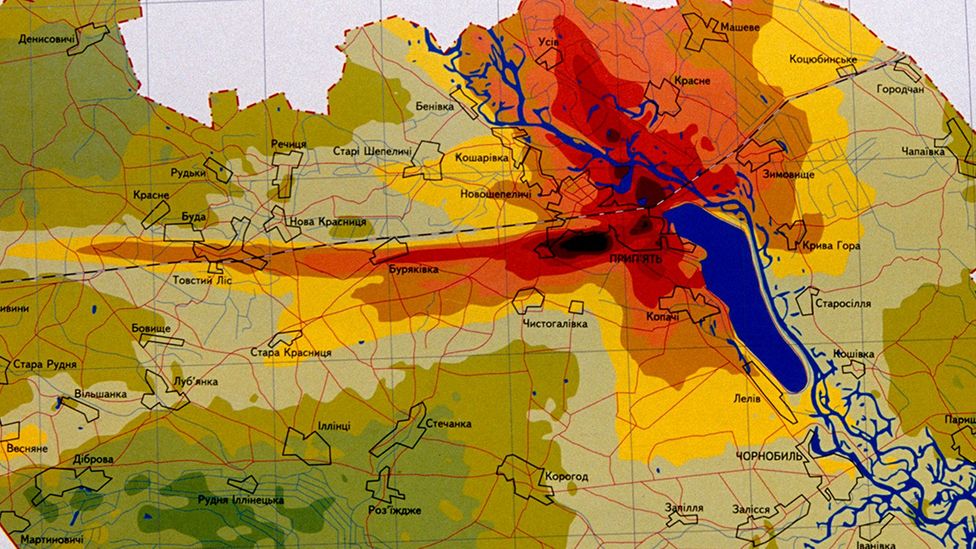
Radioactive material was carried over a wide area, mainly towards the west, by the wind in the days that followed the disaster (Credit: Getty Images)
In areas of Western Europe hit by Chernobyl fallout there have also been indications that the rates of neoplasms – abnormal tissue growths that include cancers – have been higher than in areas that escaped contamination.
“It was labelled as normal and sent all over the country, although they were told not to send it to Moscow.” – Kate Brown
But Brown believes some of the actions of those attempting to deal with the aftermath of the disaster also led to contamination spreading far further than it otherwise would. In an archive in Moscow she found records that indicated that meat, milk and other produce from contaminated plants and animals were sent all over the country.
“They came up with manuals for the meat, wool and milk industries to classify produce as high, medium and low in terms of radiation,” she says. “Meat with high levels, for example, was shoved into a freezer so they could wait until it fell. Medium and low-level meat was supposed to be mixed with clean meat and turned into sausage. It was labelled as normal and sent all over the country, although they were told not to send it to Moscow.”
Brown, who has written a book about her findings called Manual for Survival: A Chernobyl Guide to the Future, also discovered similar stories of blueberries that were over the accepted radiation limit being mixed with cleaner berries so the whole batch would fall under the regulatory limit.
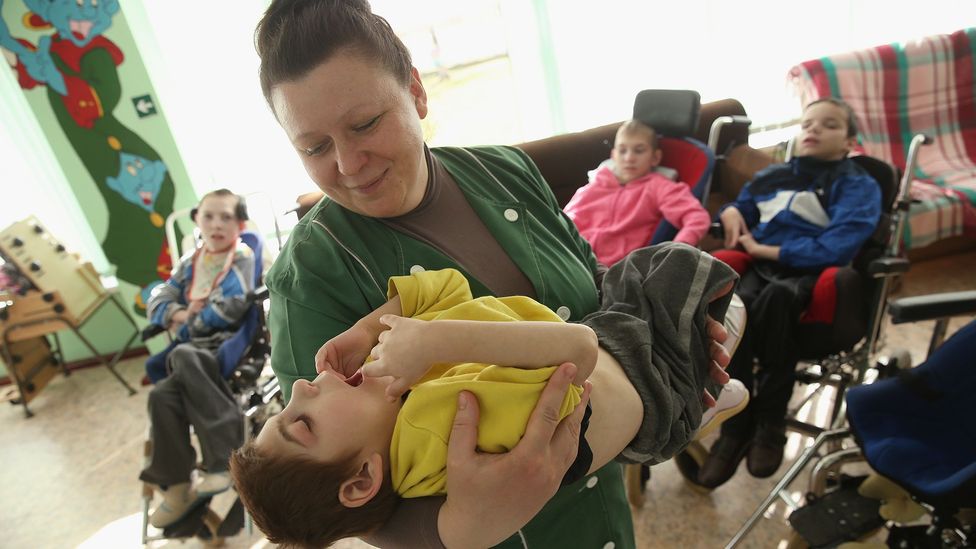
Attributing the affects of radiation exposure from Chernobyl to birth defects and other health problems in children born after the accident is controversial (Credit: Getty Images)
It meant people outside Ukraine would “wake up to a breakfast of Chernobyl blueberries” without even knowing it, she says.
Establishing the links between radiation exposure and long-term health effects, however, is a difficult task. It can take years, even decades before cancers appear and attributing them to a particular cause can be difficult.
One recent study, however, identified problems in the genomes of children who were either exposed during the disaster, or were born to parents who were exposed. It found increased levels of damage and instability in their genomes.
“Genome instability represents a significant risk of cancer,” says Aleksandra Fučić, a genotoxicologist at the Institute for Medical Research and Occupational Health in Zagreb, Croatia. The daughter of a Ukrainian woman herself, she has been working with Russian scientists to study the effects of Chernobyl’s radiation on children from the region. “In Chernobyl cases, time is not healing. Time is a latency period for cancer development.”
Other studies have found higher mutation rates in non-coding regions of the genome in children who were born in Mogilev, Belarus – where the majority of the radiactive cloud from Chernobyl fell – after the disaster.
But another major study published in 2021, close to the 35th anniversary of the disaster, found no evidence of additional DNA damage in children born to parents who were exposed to radiation during the clean-up operation after the accident. The study screened the genomes of 130 children conceived and born between 1987 and 2002, and found no increase in mutation rates mutations associated with their parent's involvement as liquidators compared to studies in the general population. The researchers note that liquidators generally experienced lower radiation doses over an extended period of time.
Fučić, however, says there have been other impacts of the disaster. Suicide rates among people involved in the clean up at Chernobyl are higher than in the general population. Studies have also found that people who reported living in the Chernobyl affected zones in Ukraine had higher rates of alcohol problems and poorer levels of mental health.
Putting a figure on exactly how many deaths around the world may result from the Chernobyl disaster is almost impossible. But despite the grim picture much of the research paints, there are some stories of hope too.
Three engineers who volunteered to drain millions of gallons of water from tanks beneath the burning reactor in the days immediately after the explosion waded through highly radioactive water and debris to reach the release valves. Their heroics are one of the most dramatic moments in HBO’s recent dramatisation of the disaster.
Astonishingly, two of the three men are still alive despite having minimal protection from the radiation during their mission. The third man, Borys Baranov, survived until 2005.
* This article was updated on 26 April 2021 to include the new study in the journal Science that found no evidence of additional mutations in the genomes of children conceived to parents involved in the clean up operation at Chernobyl.
--
Join more than one million Future fans by liking us on Facebook, or follow us on Twitter or Instagram.
If you liked this story, sign up for the weekly bbc.com features newsletter, called “The Essential List”. A handpicked selection of stories from BBC Future, Culture, Capital, and Travel, delivered to your inbox every Friday.
